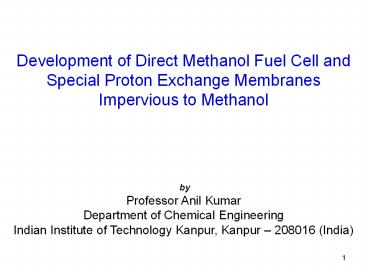Development%20of%20Direct%20Methanol%20Fuel%20Cell%20and - PowerPoint PPT Presentation
Title:
Development%20of%20Direct%20Methanol%20Fuel%20Cell%20and
Description:
1. Development of Direct Methanol Fuel Cell and. Special ... Department of Chemical Engineering. Indian Institute of Technology Kanpur, Kanpur 208016 (India) ... – PowerPoint PPT presentation
Number of Views:1567
Avg rating:3.0/5.0
Title: Development%20of%20Direct%20Methanol%20Fuel%20Cell%20and
1
Development of Direct Methanol Fuel Cell and
Special Proton Exchange Membranes Impervious to
Methanol by Professor Anil
Kumar Department of Chemical Engineering Indian
Institute of Technology Kanpur, Kanpur 208016
(India)
2
Schematic Diagram of a Fuel Cell
3
Fuel Cell Stack
4
Mechanism for Methanol Oxidation
- Electrosorption (forming Pt-CH2OH, Pt2-CHOH
- species) of methanol onto Platinum layer
deposited on MEA - Addition of oxygen to adsorbed carbon containing
intermediates generating CO2
5
Operation of Fuel Cell
6
(No Transcript)
7
(No Transcript)
8
Types of Fuel Cells
Fuel Cell Operating Conditions
Alkaline FC (AFC) Operates at room temp. to 80 0C Apollo fuel cell
Proton Exchange Membrane FC (PEMFC) Operates best at 60-90 0C Hydrogen fuel Originally developed by GE for space
Phosphoric Acid FC (PAFC) Operates best at 200 0C Hydrogen fuel Stationary energy storage device
Molten Carbonate FC (MCFC) Operates best at 550 0C Nickel catalysts, ceramic separator membrane Hydrocarbon fuels reformed in situ
Solid Oxide FC (SOFC) Operates at 900 0C Conducting ceramic oxide electrodes Hydrocarbon fuels reformed in situ
Direct Methanol Fuel Cell (DMFC) Operates best at 60-90 0C Methanol Fuel For portable electronic devices
9
Summary of Reactions and Processes in Various
Fuel Cells
10
Block Diagram of the Component Parts of a Fuel
Cell
11
Depiction of Components of Complete Fuel Cell
System
12
Polyelectrolyte Membrane Fuel Cell (PEMFC)
13
Technology Limitations with DMFC
Poor Electrode Kinetics
Mass Transport
Large activation work potential
Low MeOH concentration
CO2 Rejection
Electrode Structure
200-300 mV Cell Voltage Loss
25-150mV Cell Voltage Loss
Catalyst Development
Electrode Material Development
14
Technology Limitations with DMFC Cathode
15
Three components of the Fuel Cells
- Electrode Material Special conducting carbon
Vulcan XE-72 available with Cabot Corporation,
USA. - Anodic Catalyst Platinum-Ruthenium adsorbed on
conducting carbon. Procedure of making it is well
documented. - Cathodic Catalyst Platinum adsorbed on
conducting carbon. Procedure of making it is well
documented. - Membrane Nafion Membrane available with DuPont
USA. They create lot of problems before supplying.
16
Ion Exchange Membranes
Polystyrene (PS) Membranes
- Dense membranes used for gas separation and
pervaporation - Sulfonated PS membrane used in methanol based
fuel cells - Sulfonated PS blended with Nafion membrane
- High impact PS blended with polyaniline
- Anion exchange membranes prepared by
chloromethylation of - polystyrene
17
Experimental Section
Membrane Preparation
Styrene, AIBN, BPO, DMA, Bulk polymerization at
700 C
Casting of prepolymer syrup on wet clay support
Preparation of clay support
700 C, 12 h
Gas phase nitration of the membrane at 1100 C
Amination of the membrane using hydrazine
hydrate
Quaternization by dichloroethane and triethylamine
18
Preparation of Clay Support
Composition
Steps of Preparation
Clay raw material Composition (wt. )
Kaolin 10.15
Ball clay 12.90
Feldspar 4.08
Quartz 18.85
Calcium carbonate 22.52
Pyrophyllite 11.50
Water 20.00
I Casting Clay mixture casted on a gypsum
surface II Drying Ambient Temp 24 h 100 0C
12 h 250 0C 12 h III Sintering 900 0C 6 - 8
h IV Dip Coating Dip coated in polymerized TEOS
(tetraethyl orthosilicate) Drying, 100 0C 24
h Sintering, 1000 0C 5 h
19
Solid Oxide Electrolyte Ceramics
Overpotential ?OP ?AOP ?COP
IRinternal Perovskite Oxides La1-aAaM1-bBbO3-x
ASr2, Ln3, Ce4 MFe, Co, Ga a0.1 to
1mol BCo, Fe, Mg b0.1 to 0.5 mol High
Temperature Superconductors YBa2Cu3O7-x Piezoelect
ric material BaTiO3 Semiconductor sensors
SrTiO3 Oxygen Ion Conductors
LaGaO3-x Proton Conductor doped
BaCeO3-x Cathode Material
La0.8Sr0.2CoO3-x Working
Temperature range 100-20000C
20
Modification of the Support
21
Experimental Section
Modification Reactions
Nitration
2NaNO2H2SO4? NO NO2 H2ONa2 SO4
Amination
Quaternization
22
Membrane Characterization
Scanning electron microscopy (SEM)
Membrane layer
Ceramic Support
Crossectional view of the membrane
23
Experimental Setup for Electrodialysis
DC Power Supply
cathode
anode
HCl Solution
NaCl solution
O2
H2
Pump
Pump
Catholyte
Anolyte
24
Performance of the Membrane
- Current efficiency
- Energy consumption
KWh/mol of NaOH produced
- Operating parameters
Salt concentrations, flow rate, current density
25
Overall performance of Anion Exchange Membrane
Flow rate (ml/min) Current Density (A/m2) NaCl (N) Cell Voltage (V) Current Efficiency () Energy Consumption kWh/mol
33 254.6 4.2 4.52 92.56 0.130
66 254.6 4.2 4.30 91.62 0.133
100 254.6 4.2 4.52 88.63 0.138
66 254.6 2.5 4.54 85.07 0.146
66 254.6 5.2 4.50 96.5 0.1216
66 127.3 4.2 4.54 92.5 0.125
66 254.6 4.2 4.56 92.56 0.133
66 509.2 4.2 4.62 89.52 0.139
26
Results and Discussion
27
Space Charge Model
Schematic Diagram of a Flat Membrane
Domain of EDL
Effective pore
Schematic Diagram of a Single Pore
28
Space Charge Model
Assumptions
1.
- 2. Relt10-6 as a 10-9
- 3. Pores are long and narrow (l gtgta)
- radial and axial variation of ur neglected
- neglected
- Axial variation of potential neglected
- 4. All external forces (for example, gravity
etc.) assumed to be negligible.
29
Governing Equations
(a) Nernst Planck equation
(b) Navier Stokes equation
(c) Poisson equation
30
Space Charge Model
(d) Poisson-Boltzmann equation (PBE)
Boundary conditions
Volumetric flow rate
,
Solute Flux
Electrical Current
31
Space Charge Model
where
32
Space Charge Model
Series Solution of PBE
33
Space Charge Model
Integral expressions Analytical expressions
34
Space Charge Model
Solution Scheme
Input Js, I, cII
Start
Assume wall potential
Assume cI
Solve PBE equation 5, Calculate Js_cal eqn 11
No
Is (Js_cal - Js) lt tol
Yes
Cal I_cal using eqn 10
No
Is (I Ical)2 is min
Yes
Stop
35
Results and Discussion
S parameter Vs pore diameter at different time
interval
36
Thank You































